Oakmark Global Fund - Investor Class
Average Annual Total Returns 06/30/12
Since Inception 08/04/99 9.70%
10-year 8.67%
5-year -1.97%
1-year -8.08%
3-month -8.00%
Gross Expense Ratio as of 09/30/11 was 1.16%
Past performance is no guarantee of future results. The performance data quoted represents past performance. Current performance may be lower or higher than the performance data quoted. The investment return and principal value vary so that an investor’s shares when redeemed may be worth more or less than the original cost. The performance of the Funds does not reflect the 2% redemption fee imposed on shares redeemed within 90 days of purchase. To obtain the most recent month-end performance data, view it here.
Quarter Review
In contrast to the strong March quarter for the equity markets, the June quarter proved very difficult. Once again, fears of some sort of economic calamity in Europe roiled the markets. The Oakmark Global Fund registered a disappointing loss of 8% in the quarter. The MSCI World Index loss was 5% and the Lipper Global Fund Index lost 7%. Despite the June quarter’s outcome, the Fund’s return for the calendar six months is still positive at 7%. The MSCI World Index has returned 6% for that period and the Lipper Global Fund Index returned 5%. For the Global Fund’s fiscal nine months, the returns are 12% for the Fund, 14% for the MSCI World Index and 13% for the Lipper Global Fund Index. As always, we are most pleased to report the Fund’s 10% compound annualized rate of return since inception. The countries that detracted most from the Fund’s return in the quarter were Japan, Switzerland and Germany. Only our small positions in the U.K. and the Netherlands generated positive rates of return. The Fund holdings that detracted most were Square Enix (Japan), Credit Suisse (Switzerland), Daimler (Germany), Health Net (U.S.), and Rohm (Japan). The five largest contributors to return in the period were all from the U.S.: Union Pacific, DiscoveryCommunications, Equifax, Oracle and Snap-on.
For the calendar six months, the highest contributing countries were the U.S., Germany and Sweden. Australia led the detractors list, followed by Switzerland and Spain. Snap-on, Discovery Communications, Oracle, Equifax and Daiwa Securities Group (Japan) were the leading contributors. Square Enix, Credit Suisse, Health Net, Rohm and Canon (Japan) detracted most from the six-month return. For the nine months of the Fund’s fiscal year, the U.S., Switzerland and Sweden were the leading contributors to return while Japan, Spain and the Netherlands detracted. All five companies that led the contributors’ list were American: Snap-on, Equifax, Discovery Communications, MasterCard and Union Pacific. Detractors were Credit Suisse, Rohm, Square Enix, Health Net and Canon.
With two very strong quarters followed by a bad negative period, the past nine months have obviously been quite volatile. The Fund has experienced several periods like this, when exogenous macro factors overwhelm the stock market’s ability to bring price and value together in a rational fashion. We always find such periods to be replete with opportunity. In the recent market turbulence, U.S.-centric investors may not have realized that U.S. stocks significantly outperformed the rest of the global equity markets. Of course, this makes sense since much of the turbulence has originated in Europe, but the price declines have also been large in Japan and the emerging markets. Withal, we continue our search for value wherever we may find it, and as the next section demonstrates, we continue to find what we believe is exceptional value in Europe.
Credit Suisse was one of the worst performers for the quarter due to a weaker investment banking environment and because of negative comments about Credit Suisse in the Swiss National Bank’s (SNB) recent annual Financial Stability report. The SNB indicated that, in order to meet the Basel 3 requirements, Credit Suisse should stop its dividend payments and/or issue equity to more rapidly increase the company’s loss-absorbing capital. We found these comments odd since the SNB is not Credit Suisse’s regulator. FINMA (Credit Suisse’s regulator) is satisfied with Credit Suisse’s financial health. Additionally, Credit Suisse has until 2019 to meet Basel 3 requirements, and the head of the SNB even stated that “Credit Suisse’s plan corresponds to our assessment, but we’d like to see acceleration.” We forecast that Credit Suisse will meet Basel 3 requirements well before 2019. We already know that the Basel 3 requirements for Swiss financial institutions are some of the most stringent in the world, another example of Swiss governmental agencies’ extreme conservatism. We take capital strength and solvency very seriously, as it helps protect downside risk when investing. With little exposure to sovereign debt, excellent liquidity and a strong balance sheet that is growing stronger, Credit Suisse’s financial strength satisfies our investment criteria.
Portfolio Activity
During the quarter, the U.S. weight grew by almost 4% to 50% of the total portfolio. Rather than by design, this outcome resulted from market action. As always, we do not invest versus a benchmark, so we have no specific intention to rebalance the U.S. back to where it was before. All holdings in the Fund, both current and prospective, compete with one another for space, and the price declines in international markets make the competition more difficult for our U.S. holdings.
We initiated two new positions, Akzo Nobel and Kuehne & Nagel, and exited our investment in SAP. SAP performed well for the Fund, and its sale primarily reflects our recognition that other opportunities were more attractive.
Akzo Nobel has been on our approved list since mid-2008, but two recent events persuaded us to finally add it to the Fund. First, the share price has fallen as the company has experienced demand weakness in Europe, particularly in its consumer-oriented businesses, such as decorative paints. Over the past few years, Akzo Nobel’s restructuring program has resulted in increased profitability in its performance coatings and specialty chemicals units, and we think that this trend will continue. Management’s endeavors to improve the cost structure of both businesses, as well as its successful price adjustments to encompass raw material inflation, have boosted profitability. Management remains focused on expanding the company and improving the performance of the decorative paints division. Second, we are excited about the appointment of new CEO Ton Büchner, who took over the role in April. Mr. Büchner had been the CEO of Sulzer since 2005, and he enjoyed a strong track record. In recent years, we have become acquainted with Ton and trust that his highly regarded leadership ability will propel Akzo Nobel to greater performance.
Kuehne & Nagel, one of the world’s leading freight forwarders, was also added to the approved list in mid-2008. Economic concerns in Europe are once again enabling us to purchase this attractive company for less than 50 cents on the dollar. We’re buying Kuehne & Nagel at only a slight premium to the new-idea buy price. The company’s freight volumes have grown over 6% per annum during a very tough economic environment, and its market share has moved from number four to number two globally, mostly via organic growth. Freight forwarding is a capital-light, cash-generative business that will benefit from the growth of global trade. We certainly understand that European economic growth has been and will continue to be weak. However, two characteristics make Kuehne attractive. First, a large portion of Kuehne’s European business comes from Germany. Second, Kuehne benefits from both European imports and exports, with the latter growing at a double-digit rate despite the problems in Europe.
Hedge Discussion
We continue to believe that the U.S. dollar is undervalued relative to other global currencies. As of quarter-end, approximately 63% of the Fund’s Australian dollar, 62% of the Japanese yen, 42% of the Swiss franc and 37% the Swedish krona exposures were hedged.
Thank you for being our partners in the Oakmark Global Fund. Please feel free to contact us with your questions or comments.
As of 6/30/12, Square Enix Holdings Co., Ltd. represented 3.4%, Credit Suisse Group 2.8%, Daimler AG 2.5%, Health Net, Inc. 1.4%, ROHM Co., Ltd. 1.9%, Union Pacific Corp. 2.3%, Discovery Communications, Inc., Class C 3.4%, Equifax, Inc. 3.6%, Oracle Corp. 4.8%, Snap-on, Inc. 4.5%, Daiwa Securities Group, Inc. 3.9%, Canon, Inc. 2.5%, MasterCard, Inc., Class A 4.2%, Schweizerische Nationalbank 0%, Akzo Nobel N.V. 0.8%, Kuehne + Nagel International AG 0.9%, and SAP AG 0% of the Oakmark Global Fund’s total net assets. Portfolio holdings are subject to change without notice and are not intended as recommendations of individual stocks.
The MSCI World Index (Net) is a free float-adjusted market capitalization weighted index that is designed to measure the global equity market performance of developed markets. This benchmark calculates reinvested dividends net of withholding taxes using Luxembourg tax rates. This index is unmanaged and investors cannot invest directly in this index.
The Lipper Global Fund Index measures the performance of the 30 largest mutual funds that invest in securities throughout the world. This index is unmanaged and investors cannot invest directly in this index.
Investing in foreign securities presents risks that in some ways may be greater than in U.S. investments. Those risks include: currency fluctuation; different regulation, accounting standards, trading practices and levels of available information; generally higher transaction costs; and political risks.The discussion of the Fund’s investments and investment strategy (including current investment themes, the portfolio managers’ research and investment process, and portfolio characteristics) represents the Fund’s investments and the views of the portfolio managers and Harris Associates L.P., the Fund’s investment adviser, at the time of this letter, and are subject to change without notice.





